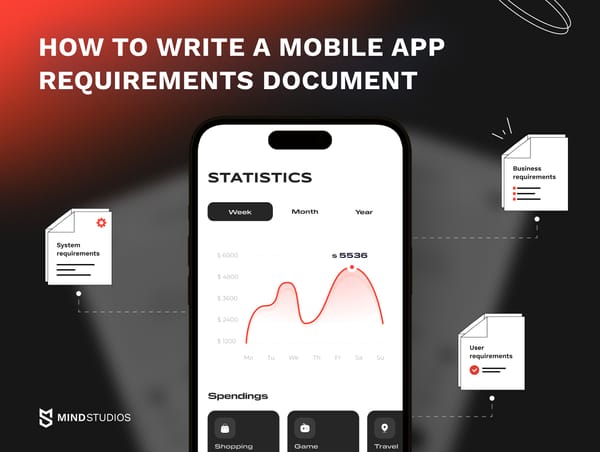If following software trends haven’t been your top priority up to now, this has to change. Why? Because as 2023 brought more economic uncertainty, it has become even more critical for the companies to make wise business decisions and pick technologies that can help them increase savings and quickly adapt when necessary.
So what are the top software development trends for 2023–2024? Mind Studios will gladly answer this question. One significant trend shaping the industry is the integration of localization into software development, enabling applications to cater to diverse languages and cultures.
With our extensive experience in sports & mental health, construction & real estate, transportation & logistics, and healthcare industries and more than 10 years on the market, we know which technologies are here to stay and prosper.
Read further to learn about the latest technology trends and how they can help you create better products.
Impact of technology choice on strategic planning
Every company that develops digital solutions and wants to be ahead of the competition has to weigh every decision it makes, especially when it comes to choosing the right technologies for your current or new project. Such technologies have to align with your strategic goals, have to leave space for scalability and flexibility, and generally be worth the costs invested.
That’s why it’s so important to know and analyze the latest trends in software development. Following trends allows you to:
- understand the current situation on the market and visualize how the market will change in the nearest future;
- figure out which technologies will remain relevant in the nearest years and which slowly become outdated;
- allocate costs wisely by investing them in technologies that are in demand;
- decide if you need to extend your software development team with new specialists familiar with a certain technology;
- minimize risks — for instance, by choosing more secure technologies;
- remain progressive and competitive.
Sounds convincing, right? So let’s move on to learning about the latest software development trends.
9 latest trends in software development for 2023–2024
Although it’s impossible to predict how software development will change over the next decade, it’s still safe to make forecasts for a year or two. Several of these technologies are new, while others have been on the market for a while. Still, all of them have made this year’s trend list.
1. Artificial intelligence (AI) and machine learning (ML)
With rapid development of AI and ML it is only natural that these technologies have become one of the latest software development trends. According to the 2022 McKinsey report, 50% of worldwide organizations have adopted AI. The technology is most commonly used for optimization of service operations, product enhancement, automating the work of contact centers, and product feature optimization.
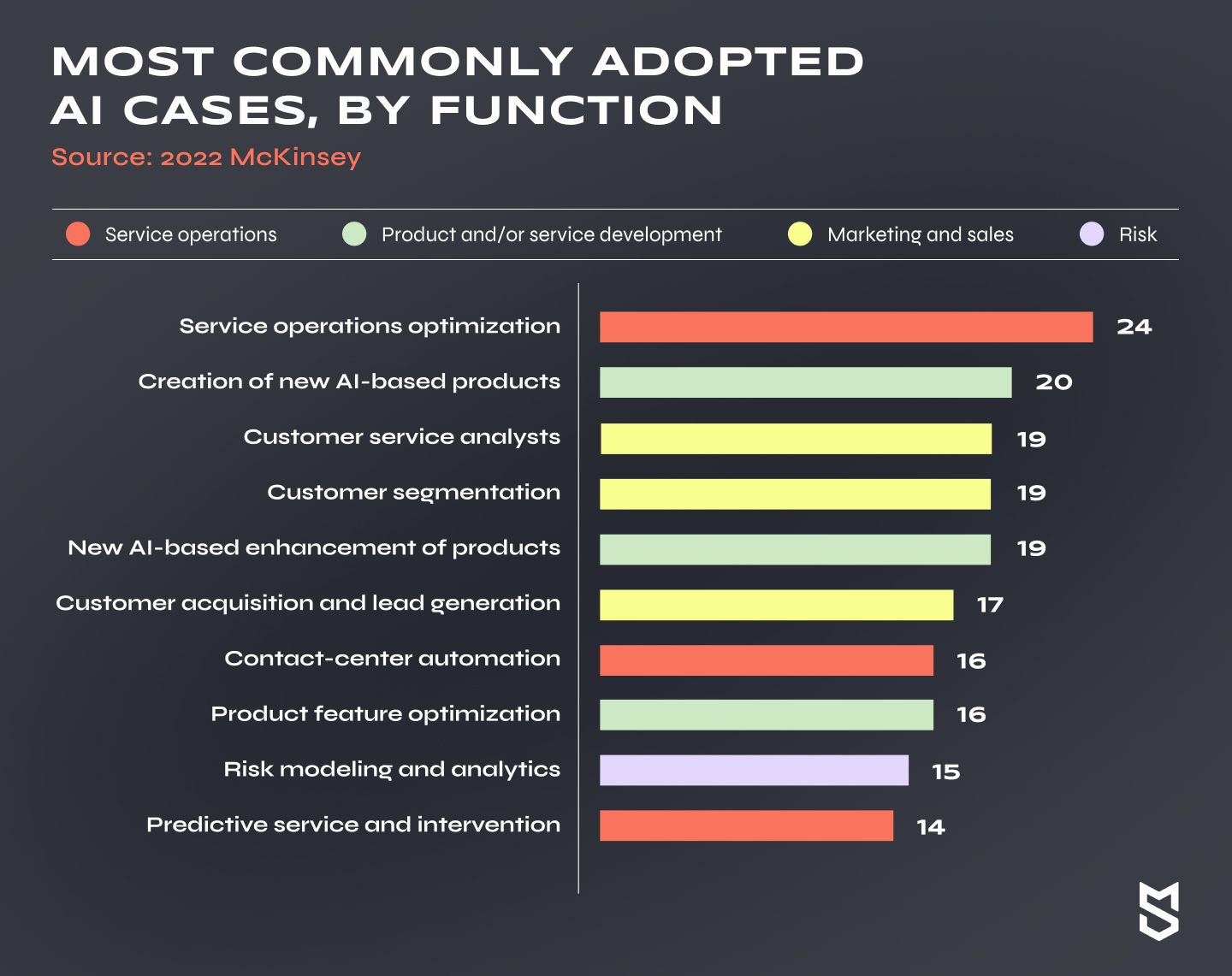
The future of this trend also seems bright: by 2024, the AI global market is expected to make more than $500 billion.
Knowing about the benefits of these technologies, it isn’t all that surprising. Here are the main reasons for using AI and ML in software development:
- to automate repetitive tasks, reducing manual effort and improving efficiency;
- to use ML algorithms to identify bugs, vulnerabilities, and improve code quality, resulting in more reliable software and shortening the software development life cycle (SDLC) processes;
- to use AI for advanced data analysis, helping optimize development processes and make data-driven decisions;
- to deliver personalized experiences and recommendations to enhance user satisfaction;
- to predict and prevent failures with the help of ML algorithms, optimizing software performance;
- to use ML models to help software evolve and adapt to changing needs.
To build AI and ML models that can help with the above-mentioned things, companies require software developers with specific knowledge and skills. Such developers have to be familiar with model learning, integration, and management, data collection, and programming languages such as C++, Java, and Python.
These days, AI and ML technologies are already widely used in various niches, from eCommerce to healthcare. The most well-known and widespread use cases are chatbots providing customer service, and virtual assistants, such as Siri.
2. DevSecOps
Security is critical for all organizations, especially the ones that are dealing with sensitive, valuable, and personal data. No wonder that the traditional DevOps system took this into consideration and implemented a new security-centered development model — DevSecOps.
DevSecOps involves security teams starting with the earliest development stages. Both developers and testers work together to make their operations, along with the final product, more safe and secure.
Market research shows that this software development trend is here to stay: the DevSecOps market size is forecasted to reach $41.66 billion by 2030, growing at a CAGR of 30.76% from 2022 to 2030.
Using DevSecOps model in software development helps:
- detect and handle security issues at the earlier stages of development;
- improve collaboration and communication between teams;
- make sure that the software complies with all regulations and industry standards;
- ensure that the development process will be highly secure;
- deliver software quicker and make it more reliable;
- enhance risk management;
- cultivate a security-conscious culture within development teams.
One of the most noteworthy examples of using DevSecOps pipelines is PayPal. Being a company that processes payments and stores clients’ financial data, PayPal was more vulnerable to cybercrime, and, obviously, had to take extra security measures such as integrating DevSecOps model in their work processes.
3. Kotlin Multiplatform/Compose Multiplatform
The Kotlin Multiplatform and Compose Multiplatform technologies go hand-in-hand and have the same goal of simplifying the development of cross-platform projects. Kotlin programming language can be used both for backend and frontend development, helping developers spend less time on code writing and maintenance. At the same time, Compose Multiplatform allows sharing user interfaces (UI) across Kotlin-based platforms.
Take a sneak peek at our Android team lead’s experience with Compose Multiplatform on our LinkedIn.
With Kotlin being Google’s official programming language for Android development, it’s safe to assume that it (along with Compose Multiplatform) will remain one of the software development trends for the next few years.
Using Kotlin Multiplatform and Compose Multiplatform in software development unlocks the following benefits:
- code reusability across platforms;
- streamlined development process with a single language;
- native performance optimization;
- consistent user interfaces across platforms;
- rapid prototyping and iteration;
- simplified code that is easier to maintain;
- access to a rich Kotlin ecosystem and tooling.
The list of apps developed with Kotlin is truly impressive. It includes Netflix, Uber, Pinterest, Evernote, Duolingo, and Coursera.
4. Big data security
Data breaches are still a major issue and a huge threat worldwide. In 2022, the average cost of a data breach in the US reached $9.44 million — an impressive and disturbing number.
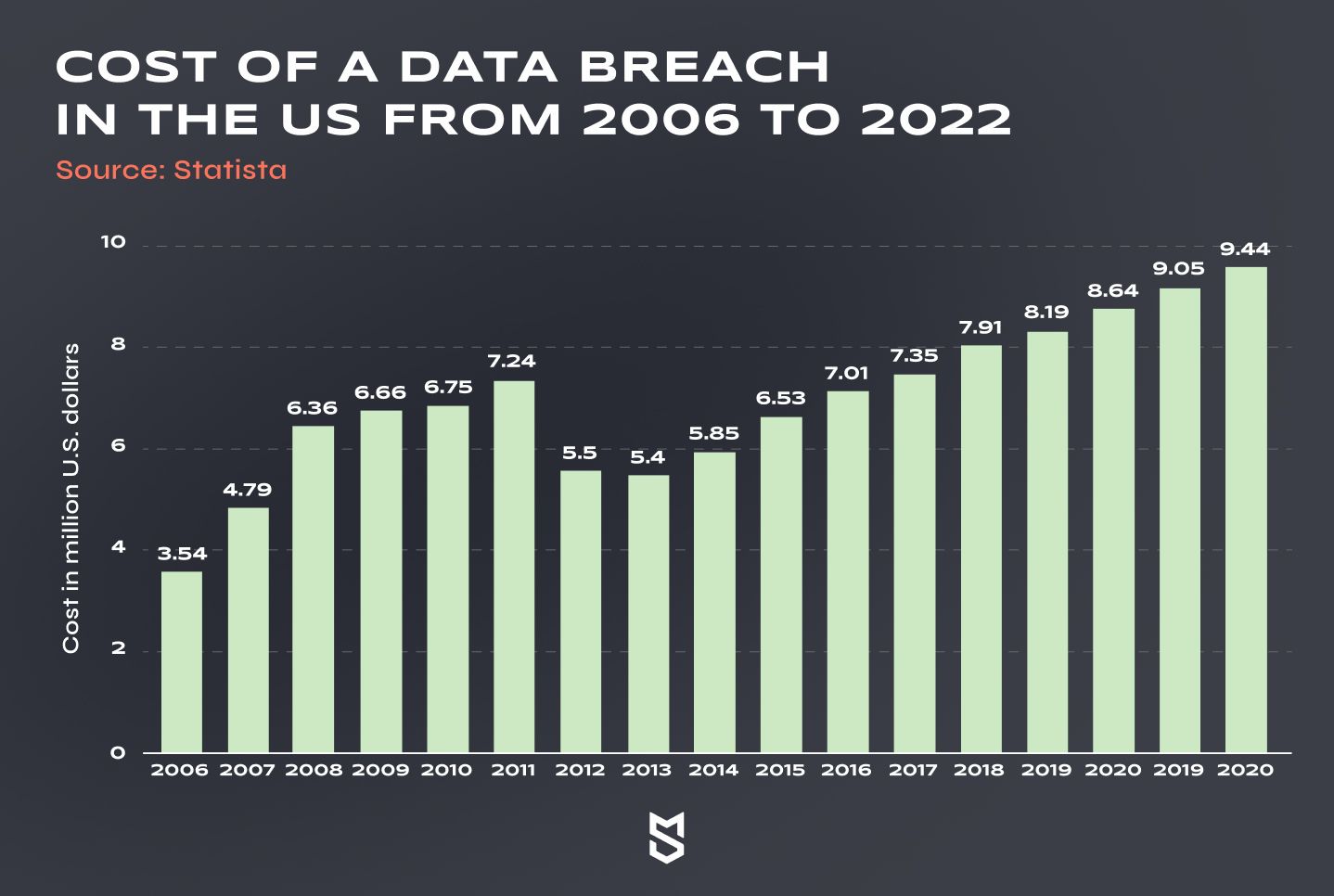
Knowing that, it’s natural to assume that big data security will be one of the main trends in the software industry for the upcoming years. At the moment, data is the cornerstone of all businesses, and is usually stored in the cloud. Therefore, protecting this data and the cloud storage is a top priority.
Here are the benefits of big data security in software development:
- data protection from unauthorized access and breaches;
- compliance with data protection regulations such as HIPAA;
- detection and prevention of security threats;
- improved data governance;
- ensured business continuity;
- enhanced customer trust and reputation;
- reliable data analytics.
Big data security is used for cloud security monitoring, incident investigation, threat hunting, user behavior and network traffic analysis, insider threat and data exfiltration detection.
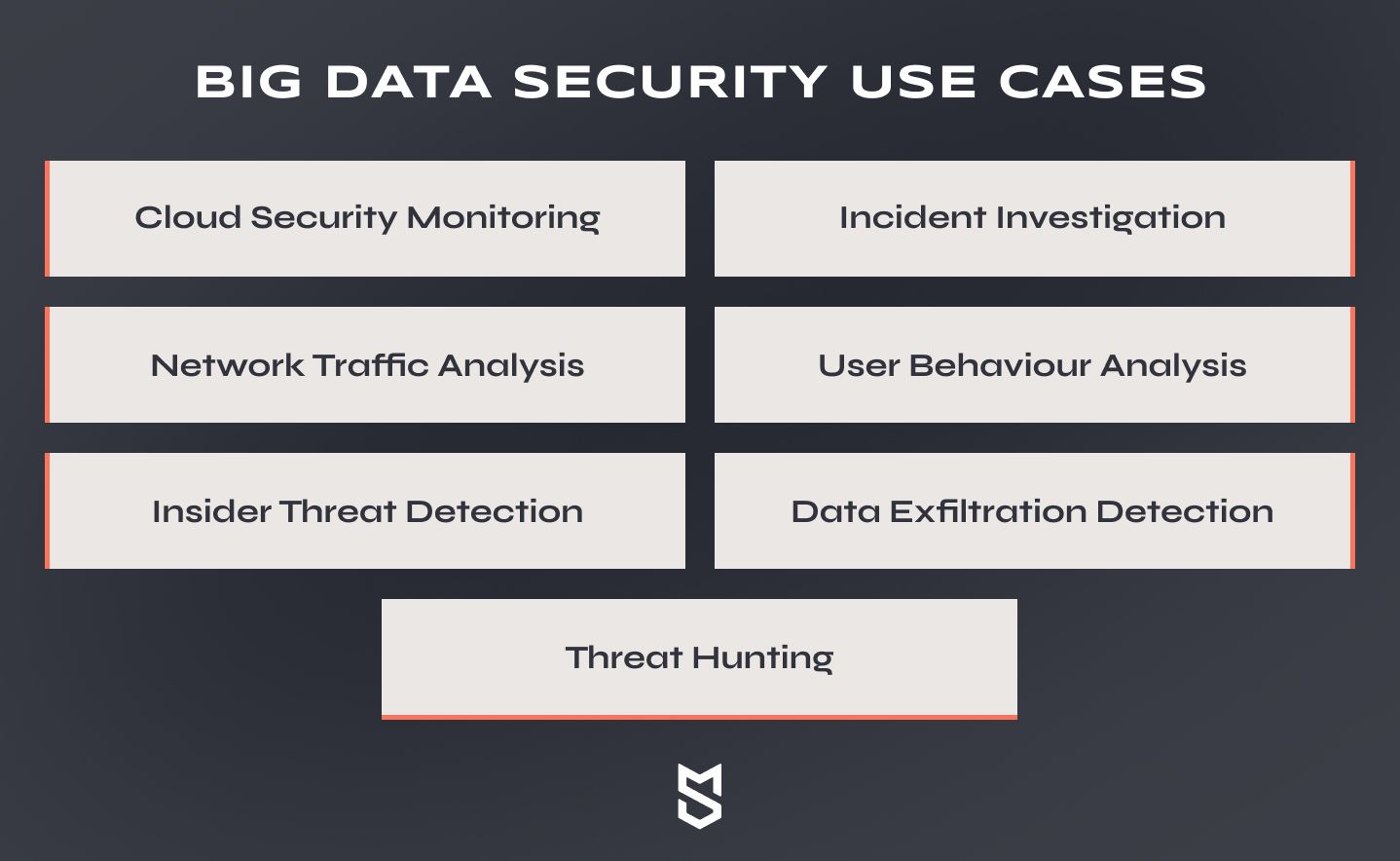
5. Blockchain technology
It’s quite difficult to talk about software engineering trends without mentioning blockchain. This is a peer-to-peer (P2P) network for making transactions that offers high security, transparency, and decentralization. This technology changed the way we view transactions, and the numbers support that. According to Statista, the worldwide spending on blockchain solutions is forecasted to reach an estimated $19 billion by 2024.
Here are the main benefits of integrating blockchain solutions in your software development projects:
- decentralization and transparency;
- immutable and secure data storage;
- efficient smart contract execution;
- improved data sharing and collaboration;
- enhanced trust and authentication.
Here’s how organizations used blockchain technology in 2021:
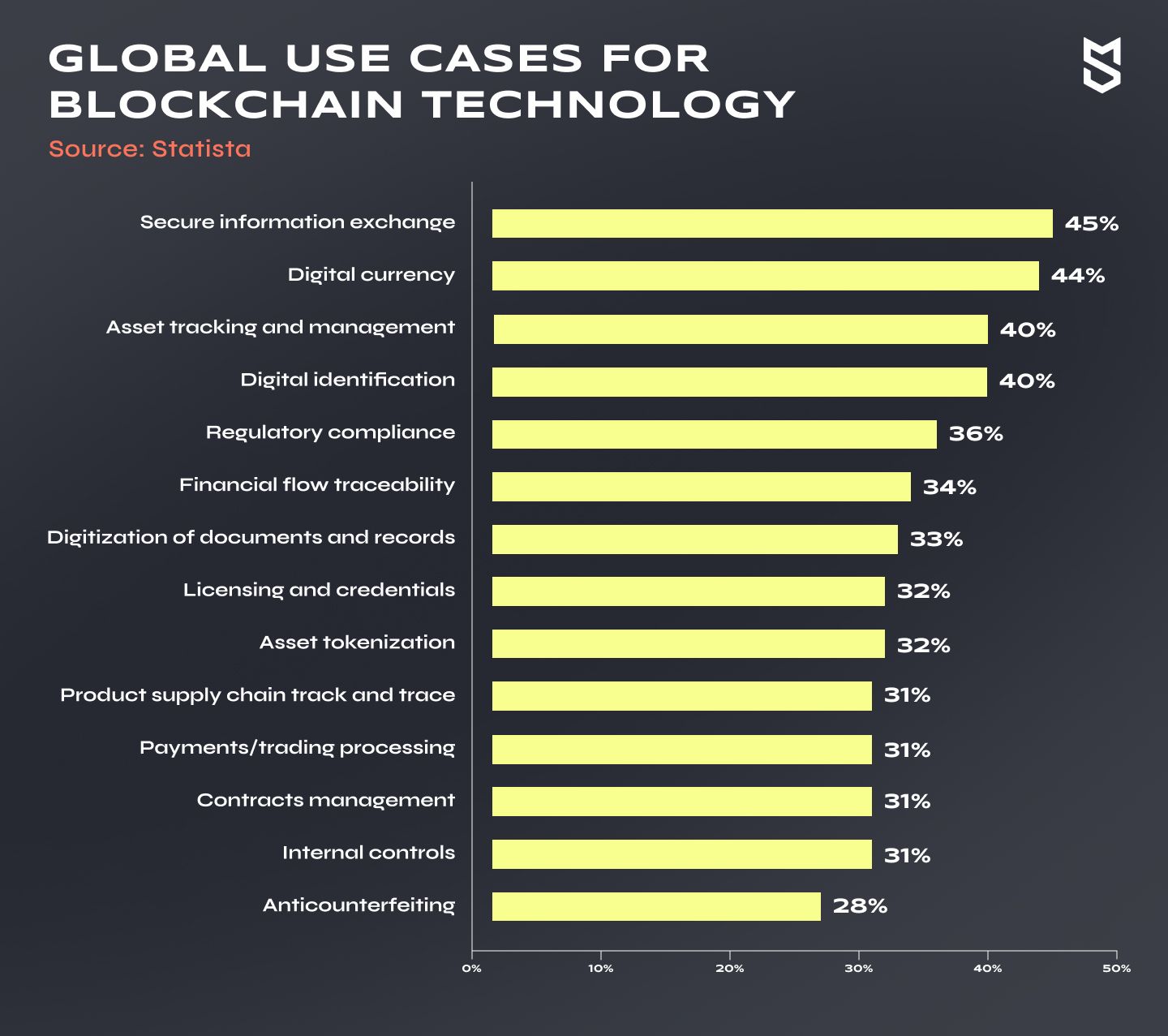
The technology was even adopted by Amazon: they created a special Amazon Managed Blockchain service.
6. Internet of Things (IoT)
Many trends in software engineering come and go, but the Internet of Things (IoT) is definitely not the one of them. The number of IoT devices worldwide is forecasted to exceed 29 billion in 2030. This is almost triple growth, compared to the year 2020 (the number of IoT devices reached 9.7 billion back then).
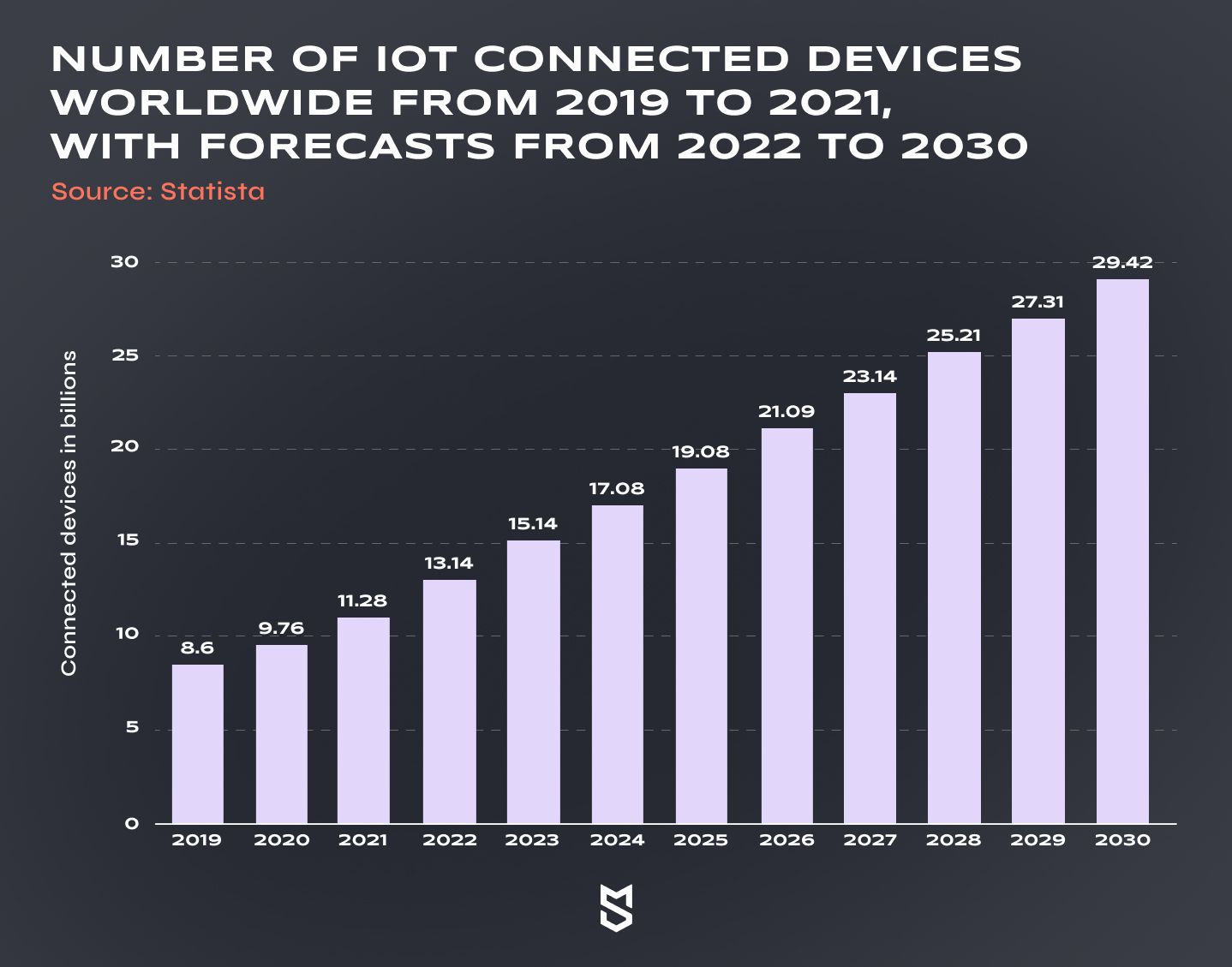
IoT is basically a network of physical objects: smart home devices, gadgets, vehicles, and other things that have sensors and exchange data using the Internet. This technology has the following benefits:
- enhanced connectivity and real-time data exchange;
- data-driven insights and informed decision-making;
- improved automation and efficiency;
- remote monitoring and control of devices;
- integration with AI and analytics for intelligent applications.
The most common use case of IoT are wearable devices, such as Apple Watch, Jawbone, and Misfit. They track your daily activity, heart rate, create training programs for you, and offer personalized health and fitness suggestions.
Internet of Behavior (IoB)
While some of the software industry trends mentioned in this article have been on the market for a while, this one is relatively new yet no less important. In fact, the IoB market is forecasted to exceed $3,592.6 billion by 2032.
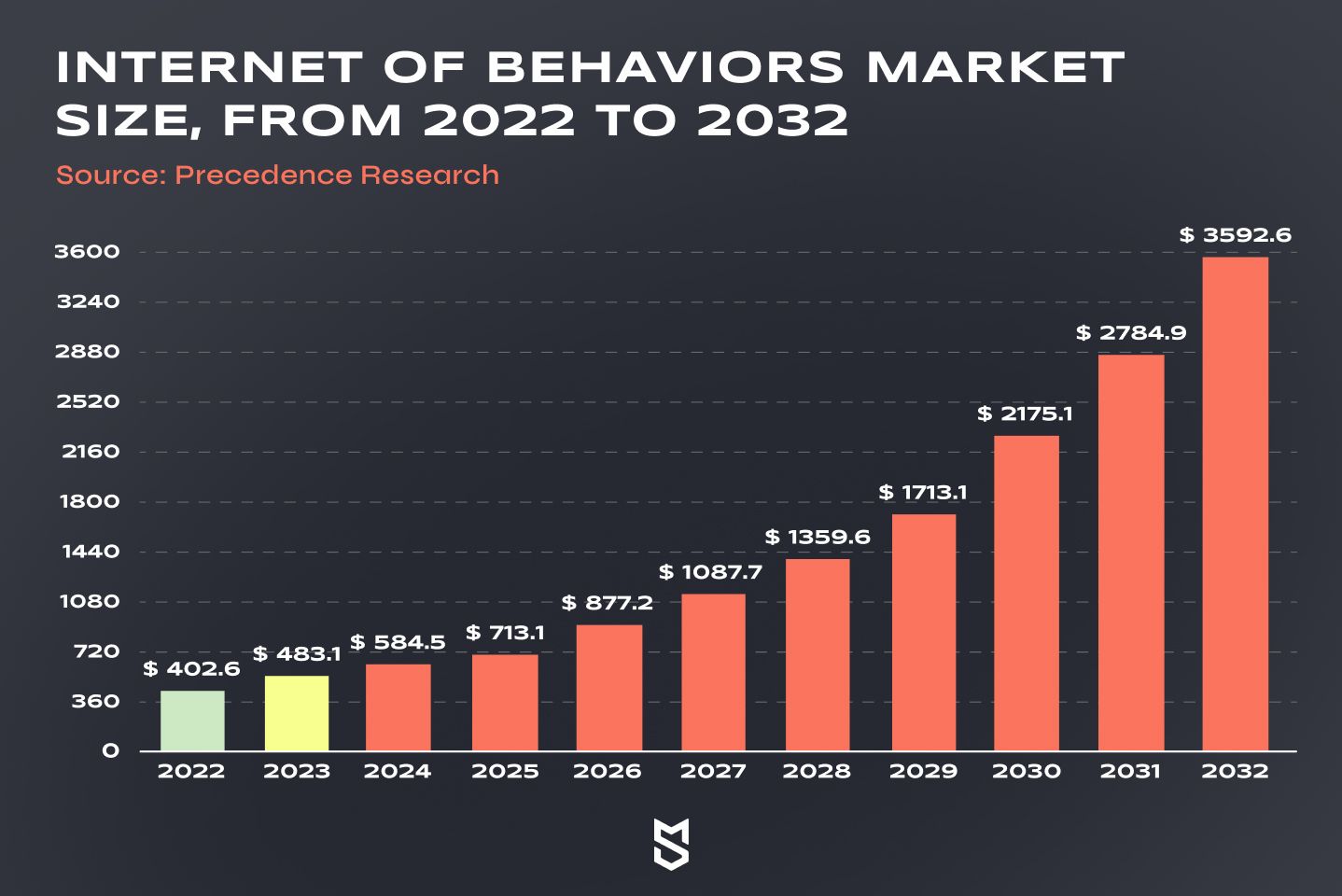
The IoB is a logical extension of the Internet of Things (IoT). It uses various technologies, such as sensors, mobile apps, wearable devices, AI and ML algorithms to collect behavioral data and then utilize it to create a more personalized user experience.
But it doesn’t end with that. IoB also offers other benefits for software development processes:
- data-driven decision-making;
- behavioral analytics;
- prediction capabilities;
- process optimization.
Internet of Behavior is already used by many well-known companies for personalization. For instance, Facebook utilizes it to select and display ads that are more relevant to target users. And Spotify uses a machine learning algorithm to come up with suggestions in its Discover Weekly feature.
8. Automation
This year, the hyper-automation market size is forecasted to exceed $155 billion. Sounds impressive, doesn’t it?
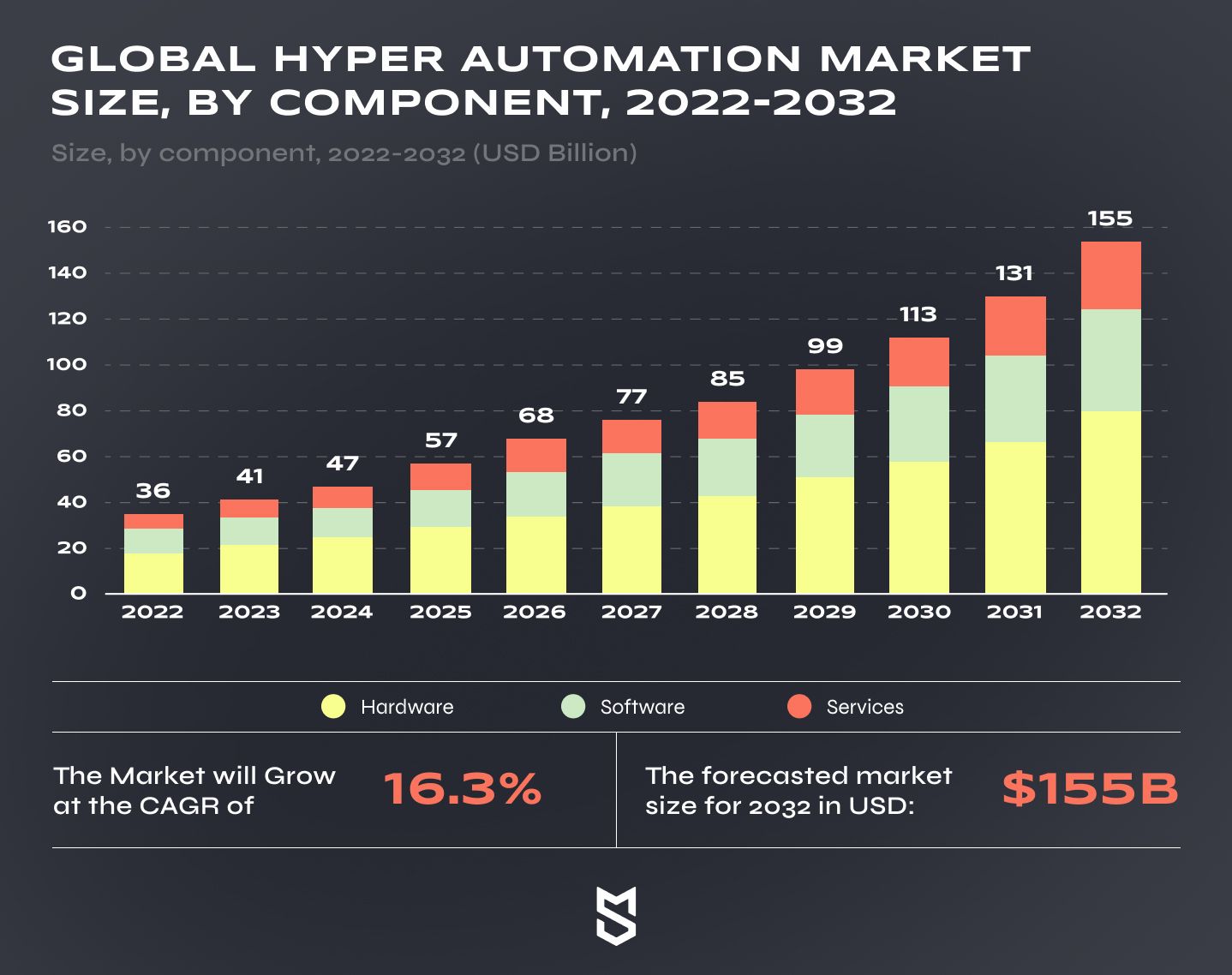
True, these days people tend to automate their work processes in every niche, software development included. While it’s obviously not possible to automate every stage of the SDLC, one can still utilize the latest technologies in software development to streamline and simplify some of its stages. Take testing as an example — 77% of companies use automation testing among other practices.
Automation of software development processes has the following benefits:
- increased staff efficiency and productivity;
- consistency and accuracy of work processes;
- time and cost savings;
- scalability and flexibility;
- improved collaboration.
To put it simply, by automating some of the routine, less important tasks, you allow your software development team to spare time and resources. As a result, they will be able to focus on more important parts of the work process.
9. Mobile game development
Mobile games have evolved massively over the years. Some of us still remember Tetris and Snake, old school yet lovely. Still, when it comes to graphics, gameplay, and all the other things, these games cannot compete with modern ones, such as Pokémon Go or Genshin Impact.
And it’s unlikely that mobile game development will become irrelevant in the near future. The smartphones become more advanced, allowing developers more options to unleash their creativity and utilize the latest technologies. And the number of smartphone users worldwide grows steadily, forecasting to reach 6.2 billion by 2028.
Investing in this trend has the following benefits:
- wide market reach, as the target audience of mobile games is very diverse both in terms of geography and demographics;
- revenue generation: mobile games unlock plenty of revenue generation and monetization options, from ads to battle passes and premium versions;
- stable user engagement and retention (as long as your game is interesting, of course);
- accessibility and convenience: as people carry their smartphones and other mobile devices wherever they go, chances are that they will play your mobile game more often than a console or PC one.
Due to these perks, many of the gaming giants consider creating mobile versions of their previously exclusively desktop games. One of the most well-known examples of that is Wild Rift — a mobile adaptation of the League of Legends.
Planning to take on a software development project?
Here’s what you need in order to do that.
- Identify project goals and requirements. No project (at least, a good one) starts without a vision. You have to clearly define the goals and requirements, as well as understand the problem you aim to solve, the target audience, platforms, and features you want to include.
- Plan and define project scope. After the vision comes the plan. Your goal is to make it realistic in terms of deadlines, deliverables, milestones, and phases. This will help both you and your software development team to plan the work and track the progress.
- Break down the project into manageable phases and set realistic timelines. Define the scope of each phase, including deliverables, milestones, and dependencies. This helps ensure a structured approach to development.
- Choose the appropriate technologies and tools based on your project requirements and goals. Consider factors such as scalability, security, platform compatibility, and development resources. If you hesitate to identify which stack would be the best for your goal, consider reaching out to an outsourcing software development company for help.
- Build the development team that has all the skills and expertise your project requires. Roles may include software developers, designers, testers, project managers, and other specialists. At this stage, you can also decide between in-house vs outsourcing: choose what feels the most appropriate for your long-term needs and goals.
- Implement and test. Develop the software solution based on the defined scope and requirements. Don’t forget to test the software throughout the development process to identify and fix any issues or bugs. Quality assurance and user acceptance testing are crucial if you want to deliver a reliable and user-friendly product.
- Deploy and maintain. Once all is done, it’s time for the world to finally see your project. Keep in mind that once you deploy your solution, you’ll have to monitor it closely as some of the performance issues or security vulnerabilities might emerge at this point.
- Plan for continuous improvement by gathering user feedback, monitoring performance metrics, and analyzing data. Use this feedback to enhance the software, introduce new features, and address evolving user needs.
It might be difficult to develop and deploy a successful project if you haven’t dealt with software development before. No matter how fresh and brilliant your idea is, you still need help from expert developers to turn it into reality.
Mind Studios is always ready to support you and your vision, creating top-quality software for you. Our knowledge and expertise allows us to be not merely executors but also advisors. We can offer you market insights, help pick the most relevant tech stack, calculate software development costs, and many more. Don’t hesitate to contact us for a first free consultation!
Conclusion
As technologies develop and change, so do the trends in the IT industry. What was relevant a couple of years ago might not be relevant now. And if you’re planning to develop modern solutions, it is critical to understand what trends and technologies to utilize and what to cast aside.
The main trends for the upcoming year or two will most likely be the following:
- Artificial intelligence and machine learning
- DevSecOps
- Kotlin Multiplatform/Compose Multiplatform
- Big data security
- Blockchain technology
- Internet of Things
- Internet of Behavior
- Automation
- Mobile game development
If you want to learn more about which trends will benefit your specific project and how to implement them, reach out to Mind Studios. We’ll gladly share our insights with you!



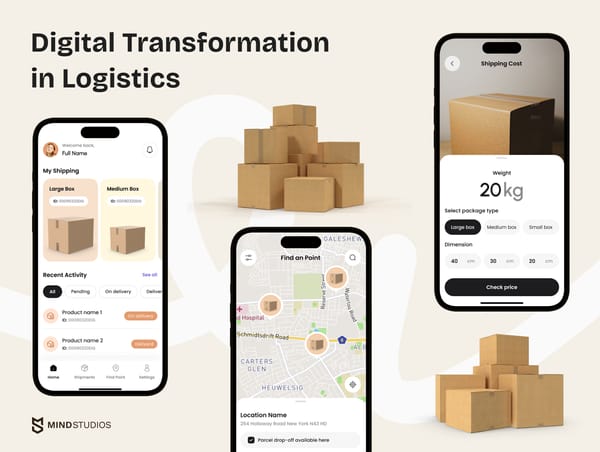
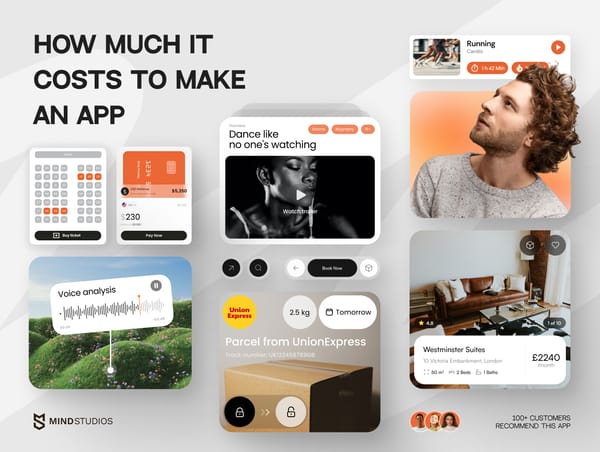
![How to Create an On-Demand Medicine Delivery App [Expert Guide]](https://themindstudios.com/blog/content/images/size/w600/2025/03/IMG-1-Cover-6.jpg)

